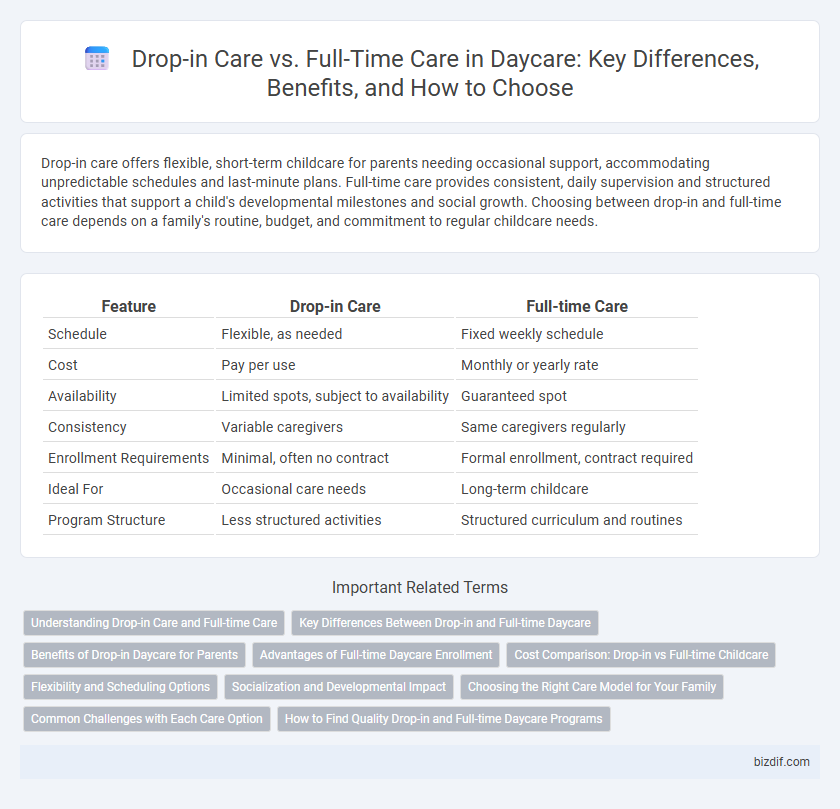Drop-in care offers flexible, short-term childcare for parents needing occasional support, accommodating unpredictable schedules and last-minute plans. Full-time care provides consistent, daily supervision and structured activities that support a child's developmental milestones and social growth. Choosing between drop-in and full-time care depends on a family's routine, budget, and commitment to regular childcare needs.
Table of Comparison
| Feature | Drop-in Care | Full-time Care |
|---|---|---|
| Schedule | Flexible, as needed | Fixed weekly schedule |
| Cost | Pay per use | Monthly or yearly rate |
| Availability | Limited spots, subject to availability | Guaranteed spot |
| Consistency | Variable caregivers | Same caregivers regularly |
| Enrollment Requirements | Minimal, often no contract | Formal enrollment, contract required |
| Ideal For | Occasional care needs | Long-term childcare |
| Program Structure | Less structured activities | Structured curriculum and routines |
Understanding Drop-in Care and Full-time Care
Drop-in care offers flexible, short-term childcare services ideal for parents with unpredictable schedules or occasional needs, allowing children to attend daycare only when required. Full-time care provides consistent, daily attendance with structured routines, supporting early childhood development through continuous learning and socialization opportunities. Understanding the difference helps parents choose the best option based on their childcare needs, budget, and desired level of engagement in their child's daily activities.
Key Differences Between Drop-in and Full-time Daycare
Drop-in daycare offers flexible, on-demand childcare services ideal for occasional use, whereas full-time daycare provides consistent daily care with structured schedules and routines. Drop-in care typically lacks guaranteed availability and may have higher hourly rates, while full-time care often comes with a fixed monthly fee and priority enrollment. Parents choosing between the two should consider their childcare needs, budget, and the importance of routine for their child's development.
Benefits of Drop-in Daycare for Parents
Drop-in daycare offers parents unmatched flexibility by allowing care on an as-needed basis, which accommodates irregular work schedules and unexpected commitments. It reduces long-term financial obligations compared to full-time care, making it a cost-effective solution for occasional use. Parents benefit from the ability to maintain social interactions and developmental activities for their children without committing to daily attendance.
Advantages of Full-time Daycare Enrollment
Full-time daycare enrollment offers consistent daily structure, promoting steady social and cognitive development in children. It provides reliable childcare, allowing parents to maintain regular work schedules without interruptions. Access to full-time care also fosters stronger relationships with caregivers and peers, enhancing emotional security and early learning opportunities.
Cost Comparison: Drop-in vs Full-time Childcare
Drop-in care offers flexible, pay-as-you-go pricing, making it ideal for parents needing occasional childcare without a long-term commitment. Full-time childcare generally involves a fixed monthly fee, providing cost savings for families requiring consistent, daily care. Evaluating the hourly rate reveals drop-in care tends to be more expensive per hour, while full-time care is more economical for regular use.
Flexibility and Scheduling Options
Drop-in care offers unparalleled flexibility, allowing parents to schedule childcare on an as-needed basis without long-term commitments. Full-time care provides consistent scheduling, ideal for families requiring regular, structured childcare from Monday to Friday. Choosing between them depends on the family's routine and the need for adaptable versus fixed care hours.
Socialization and Developmental Impact
Drop-in care offers flexible socialization opportunities by allowing children to interact with different peers and adapt to varied environments, which can enhance social skills and resilience. Full-time care provides consistent social routines and deeper peer relationships, promoting stronger emotional bonds and sustained developmental progress. Both care types impact developmental milestones uniquely, with full-time care often supporting structured learning and drop-in care fostering adaptability and varied social experiences.
Choosing the Right Care Model for Your Family
Drop-in care offers flexible, on-demand childcare ideal for parents with varying schedules, while full-time care provides consistent, structured support crucial for children's routine development. Assessing your family's daily routine, budget, and your child's social and educational needs helps determine which care model maintains stability and fosters growth. Prioritize communication with caregivers and alignment with your family values to ensure the chosen option promotes both your child's well-being and your peace of mind.
Common Challenges with Each Care Option
Drop-in care often presents scheduling uncertainties and limited availability, causing difficulties for parents needing consistent support. Full-time care may involve higher costs and less flexibility, challenging families with variable work hours or changing childcare needs. Both care options require careful consideration of convenience, budget, and the child's social and developmental requirements.
How to Find Quality Drop-in and Full-time Daycare Programs
Finding quality drop-in and full-time daycare programs involves researching licensed centers with trained, experienced caregivers who follow state regulations. Reviews and recommendations from other parents provide insights into the daycare's environment, safety protocols, and educational activities. Visiting the facility to observe cleanliness, staff-to-child ratios, and caregiver interaction with children helps ensure a nurturing and reliable childcare option.
Drop-in Care vs Full-time Care Infographic

 bizdif.com
bizdif.com